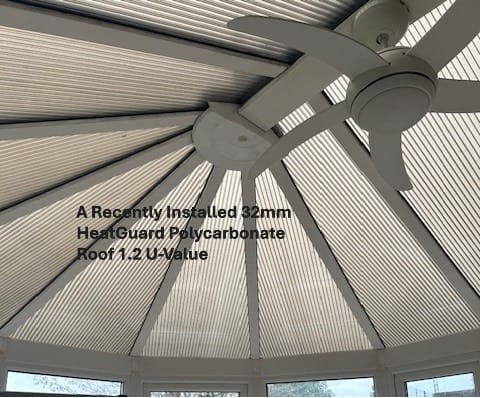
A Professional You Can Trust.
Robby Branson Builders Ltd
Choosing the right material for your conservatory roof and windows is critical to achieving comfort, energy efficiency, and cost savings. Many homeowners struggle to understand technical terms like U-Value, solar heat reflection, and light transmission, while polycarbonate roofing is often overlooked or misunderstood. Let’s break these options down into real-world benefits to help you make an informed decision.


| Material Type | U-Value (Lower is Better) | Solar Reflection (Higher is Better) | Light Transmission (Optimal Balance) | Noise Insulation (dB Reduction) | Impact Resistance | Potential Energy Savings |
|---|---|---|---|---|---|---|
| 16mm Twin-Wall Polycarbonate | 2.8 | 30% | 85% | ~15 dB | Poor (Brittle Over Time) | Minimal |
| 25mm Multi-Wall Polycarbonate | 1.5 | 45% | 70% | ~20 dB | High (Improved UV & Impact Resistance) | Up to 10% off heating costs |
| 32-35mm Multi-Wall Polycarbonate (e.g., SolarGuard) | 1.2 | 50% | 65% | ~23 dB | Very High (Enhanced UV & Impact Resistance) | Up to 15% off heating costs |
| Ambi Blue Self-Cleaning Glass | 0.9 | 70% | 50% | ~30 dB | High | Best balance for year-round efficiency |
| Ambi Ultra Glass | 1.0 | 65% | 55% | ~30 dB | High | Best for maximum insulation |
| Ambi Aqua Self-Cleaning Glass | 1.1 | 60% | 60% | ~30 dB | High | Balanced performance with self-cleaning technology |
| Ambi Sunshade Blue Self-Cleaning Glass | 1.0 | 75% | 45% | ~30 dB | High | Best for high sun-exposed areas |
While roofing materials have the biggest impact on heat retention and glare reduction, window glass selection also plays a role in energy efficiency.
💰 Heating Cost Reduction: Windows with low U-Value glass (such as Ambi Ultra or Ambi Aqua) help reduce winter heat loss, lowering heating expenses.
🔆 Cooling Cost Savings: High solar reflection glass like Ambi Sunshade Blue prevents excessive solar gain, reducing air conditioning needs.
🔍 Real-Life Example: If your home heating costs £1,500 per year, upgrading both roofing and window glass can increase total energy savings up to £400 annually, depending on the climate and exposure.
Selecting the best material for your conservatory depends on your budget, insulation needs, and durability expectations.

Both glass and polycarbonate technologies continue to evolve, and future innovations could bring even more energy-saving benefits. However, achieving true thermal efficiency may require additional improvements beyond just upgrading glass or polycarbonate. Enhancing conservatories, sunrooms, orangeries, living roofs, existing lanterns, or flat skylights can further optimize energy performance.
💡 Want expert advice on the best glass and polycarbonate materials for your conservatory and windows? Get in touch, and we’ll help you find the perfect fit! 🚀
We hope you find the information on glass and polycarbonate useful, but if you have any questions or need help, send us a message or request our FREE MOT. You do have to sign in and confirm these days to comply with government rules. Sorry for the inconvenience.
Author Rob
